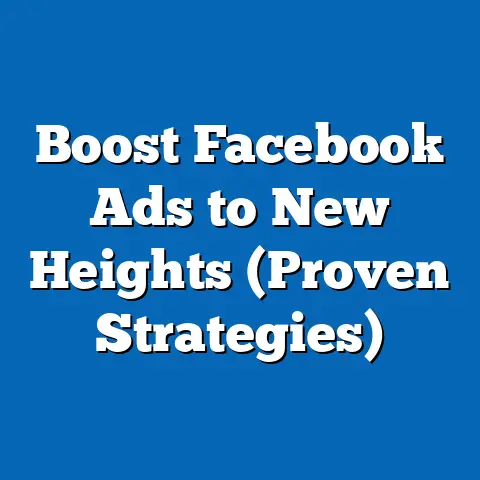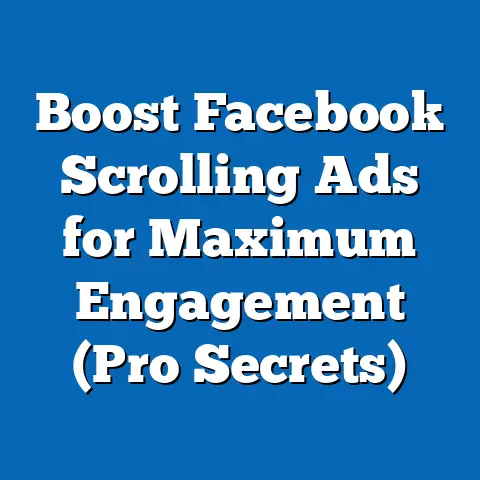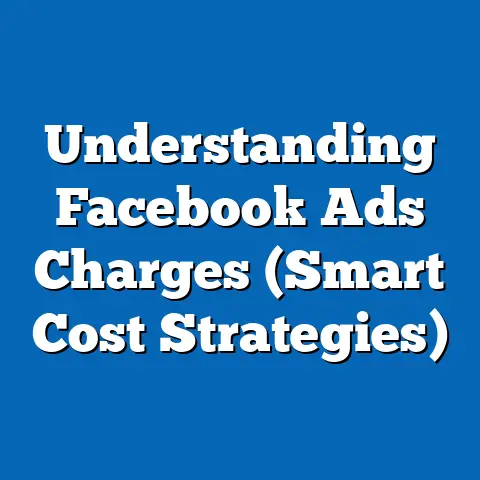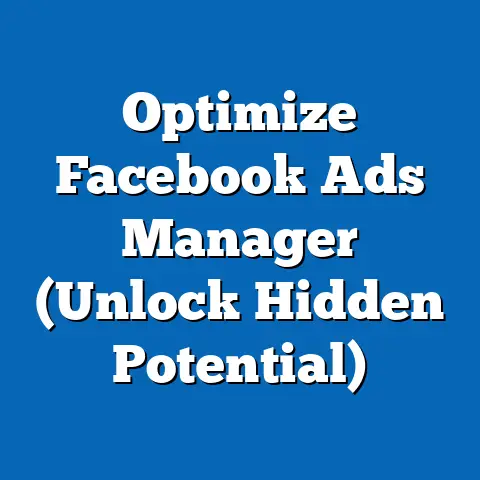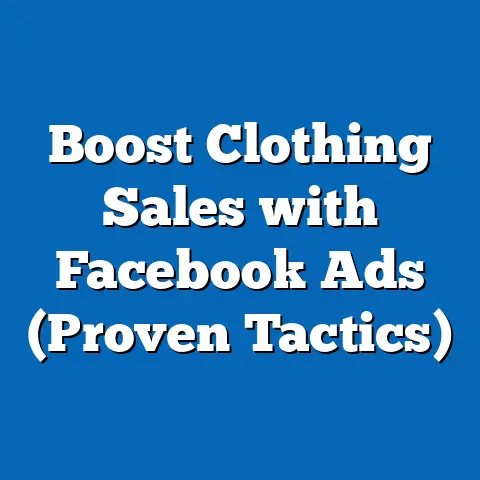Maximize Facebook Ads Effectiveness (Proven Strategies)
Facebook advertising, when approached strategically, is far more than just an expense; it’s a powerful investment that can unlock significant growth for your business. I’ve seen firsthand how businesses, both large and small, have transformed their visibility, engagement, and ultimately, their bottom line through well-executed Facebook ad campaigns. Think of your advertising budget as an investment portfolio. Just as you wouldn’t throw money into stocks without a plan, you shouldn’t launch Facebook ads without a clear strategy designed to maximize your return.
The key to unlocking this potential lies in understanding that effective Facebook advertising is a blend of art and science. It requires a deep understanding of your target audience, compelling creative content, strategic budgeting, and relentless optimization. Simply throwing money at the platform and hoping for the best is a recipe for disappointment.
In this guide, I’ll share proven strategies I’ve learned over years of experience managing Facebook ad campaigns, from the foundational principles to advanced techniques. My goal is to equip you with the knowledge and tools you need to treat your Facebook ads as a high-return investment, driving meaningful results for your business. Let’s dive in!
Section 1: Understanding the Facebook Advertising Landscape
Facebook’s advertising ecosystem is a behemoth, reaching billions of users worldwide. As of 2023, Facebook boasts over 2.9 billion monthly active users, a staggering figure that represents a massive potential audience for your brand. This sheer scale, however, also means that competition for attention is fierce. To stand out, you need to understand the nuances of the platform and its targeting capabilities.
One of the most significant advantages of Facebook advertising is its unparalleled ability to target specific customer segments. Unlike traditional advertising methods that rely on broad demographics, Facebook allows you to reach users based on a wealth of data, including:
- Demographics: Age, gender, location, education, relationship status, job title, etc.
- Interests: Hobbies, passions, favorite brands, pages they’ve liked, etc.
- Behaviors: Purchase history, online activity, device usage, travel habits, etc.
This granular targeting allows you to craft highly relevant ads that resonate with your ideal customers, increasing the likelihood of engagement and conversion.
However, targeting is only one piece of the puzzle. Before you even begin setting up your ads, it’s crucial to define clear objectives for your campaigns. Are you looking to:
- Increase Brand Awareness? Focus on reaching a wide audience and generating impressions.
- Generate Leads? Target users likely to be interested in your product or service and encourage them to sign up for your email list or request a demo.
- Drive Sales Conversions? Target users who have shown interest in your products or services and encourage them to make a purchase.
Defining your objectives upfront will help you align your strategies effectively, ensuring that your ads are optimized to achieve your desired results. Without a clear goal in mind, you’re essentially wandering in the dark, hoping to stumble upon success.
Key Takeaway: Facebook advertising offers unparalleled reach and targeting capabilities, but success hinges on understanding your audience and defining clear campaign objectives.
Section 2: Crafting Compelling Ad Content
Even with the most precise targeting, your ads will fall flat if the content isn’t compelling. Think of your ad as a mini-sales pitch. You have a limited amount of time and space to capture attention, convey your message, and persuade users to take action.
Here are some key elements of high-performing ad copy:
- Strong Headline: Your headline is the first thing users will see, so it needs to be attention-grabbing and relevant to their interests. Use strong verbs, intriguing questions, or compelling statistics to pique their curiosity.
- Engaging Visuals: In a visually driven platform like Facebook, your images or videos are crucial. Use high-quality, eye-catching visuals that are relevant to your message and resonate with your target audience. Consider using professional photography or video production to elevate your ads.
- Clear Call to Action (CTA): Tell users exactly what you want them to do. Use clear and concise CTAs like “Shop Now,” “Learn More,” “Sign Up,” or “Get Started.” Make sure your CTA is prominent and easy to click.
Storytelling is also a powerful tool for creating ads that resonate with audiences. Instead of simply listing features and benefits, try weaving a narrative that connects with users on an emotional level.
- Customer Testimonials: Share stories from satisfied customers to build trust and credibility.
- Case Studies: Showcase how your product or service has helped others achieve their goals.
- Behind-the-Scenes Content: Give users a glimpse into your company culture and values.
I once ran a campaign for a local bakery, and instead of just showing pictures of their pastries, we created a short video featuring the baker sharing his passion for his craft and the history of his family’s recipes. This personal touch resonated deeply with the local community, resulting in a significant increase in sales.
Finally, don’t be afraid to A/B test your ad content. Experiment with different headlines, visuals, CTAs, and messaging to see what works best for your audience. Facebook’s Ads Manager makes it easy to run A/B tests and track the performance of different ad variations. I always recommend testing at least two different versions of your ad to identify the winning combination.
Key Takeaway: Compelling ad content is essential for capturing attention and driving results. Focus on creating strong headlines, engaging visuals, clear CTAs, and leveraging storytelling to connect with your audience. Don’t forget to A/B test your ads to optimize performance.
Section 3: Utilizing Facebook Ad Formats and Features
Facebook offers a variety of ad formats and features that can be used to achieve different campaign goals. Understanding these options and how to use them effectively is crucial for maximizing your ROI.
Here are some of the most popular ad formats:
- Image Ads: Simple and straightforward, image ads are a great way to showcase your product or service with a single, eye-catching image.
- Video Ads: Video ads are highly engaging and can be used to tell a story, demonstrate a product, or share a customer testimonial.
- Carousel Ads: Carousel ads allow you to showcase multiple images or videos in a single ad, making them ideal for highlighting different products or features.
- Slideshow Ads: Slideshow ads are a cost-effective way to create a video-like experience using a series of images.
- Collection Ads: Collection ads are designed for e-commerce businesses and allow users to browse and purchase products directly from the ad.
Each format has its own strengths and weaknesses, so it’s important to choose the one that best aligns with your campaign goals and target audience.
Beyond ad formats, Facebook offers a range of features that can enhance your advertising efforts:
- Facebook Pixel: The Facebook Pixel is a snippet of code that you install on your website to track conversions and user behavior. This data can be used to improve ad targeting, optimize your website, and measure the effectiveness of your campaigns.
- Retargeting: Retargeting allows you to show ads to users who have previously interacted with your website or Facebook page. This is a highly effective way to re-engage potential customers and drive conversions.
- Lookalike Audiences: Lookalike audiences allow you to target users who share similar characteristics with your existing customers. This is a great way to expand your reach and find new customers who are likely to be interested in your products or services.
I’ve personally seen the power of retargeting firsthand. I once worked with an online clothing retailer who was struggling to convert website visitors into paying customers. By implementing a retargeting campaign that showed ads to users who had abandoned their shopping carts, we were able to increase their conversion rate by over 20%.
Key Takeaway: Facebook offers a variety of ad formats and features that can be used to achieve different campaign goals. Understanding these options and how to use them effectively is crucial for maximizing your ROI. Don’t underestimate the power of the Facebook Pixel, retargeting, and lookalike audiences.
Section 4: Budgeting and Bidding Strategies
Setting a budget for your Facebook ads is a critical step in ensuring that your campaigns are cost-effective and achieve your desired results. There are two main budgeting options:
- Daily Budget: Set a fixed amount that you’re willing to spend each day.
- Lifetime Budget: Set a total amount that you’re willing to spend over the entire duration of the campaign.
The best option for you will depend on your campaign goals and how much control you want to have over your spending. I typically recommend starting with a daily budget, especially when you’re first launching a campaign, as it allows you to monitor performance and make adjustments more easily.
Allocating your budget effectively is also crucial. Consider the following factors:
- Target Audience Size: The larger your target audience, the more you’ll need to spend to reach them.
- Competition: The more competition there is for your target audience, the higher your bids will need to be.
- Campaign Goals: If you’re aiming for conversions, you’ll likely need to spend more than if you’re simply trying to increase brand awareness.
Facebook offers several bidding strategies to help you optimize your ad spend:
- Cost-Per-Click (CPC): You pay each time someone clicks on your ad.
- Cost-Per-Impression (CPM): You pay for every 1,000 impressions your ad receives.
- Cost-Per-Action (CPA): You pay only when someone takes a specific action, such as making a purchase or signing up for your email list.
The best bidding strategy for you will depend on your campaign goals and budget. CPC is a good option if you’re focused on driving traffic to your website. CPM is a good option if you’re focused on increasing brand awareness. CPA is a good option if you’re focused on driving conversions.
Monitoring your ad spend is essential for ensuring that your campaign remains cost-effective while achieving your desired results. Regularly check your Facebook Ads Manager to track your performance and make necessary adjustments.
I remember working with a client who was overspending on their Facebook ads without seeing a significant return. By carefully analyzing their ad spend and adjusting their bidding strategy, we were able to reduce their costs by 30% while still achieving their campaign goals.
Key Takeaway: Setting a budget and choosing the right bidding strategy are crucial for maximizing your ROI. Consider your target audience size, competition, and campaign goals when allocating your budget. Regularly monitor your ad spend and make necessary adjustments to ensure your campaign remains cost-effective.
Section 5: Analyzing and Optimizing Campaign Performance
Analyzing and optimizing your campaign performance is an ongoing process that’s essential for achieving long-term success. You can’t just set it and forget it. Facebook Ads Manager provides a wealth of data that you can use to gain insights into audience engagement and campaign effectiveness.
Here are some key metrics to track:
- Click-Through Rate (CTR): The percentage of users who see your ad and click on it. A high CTR indicates that your ad is relevant and engaging.
- Conversion Rate: The percentage of users who click on your ad and then take a desired action, such as making a purchase or signing up for your email list. A high conversion rate indicates that your landing page is effective and your offer is compelling.
- Return on Ad Spend (ROAS): The amount of revenue you generate for every dollar you spend on advertising. A high ROAS indicates that your campaign is profitable.
Interpreting this data is key to understanding what’s working and what’s not. For example, if your CTR is low, it may indicate that your ad copy or visuals are not compelling enough. If your conversion rate is low, it may indicate that your landing page is not optimized or your offer is not attractive enough.
Based on your performance data, you can take several actions to optimize your campaign:
- Pause Underperforming Ads: If an ad is not generating clicks or conversions, pause it and focus on the ads that are performing well.
- Adjust Targeting: If your ads are not reaching the right audience, adjust your targeting criteria to be more specific.
- Refine Ad Copy and Visuals: If your ad copy or visuals are not resonating with your audience, experiment with different variations to see what works best.
- Scale Successful Ads: Once you’ve identified ads that are performing well, scale them by increasing your budget or expanding your targeting.
I once worked with a client who was seeing a decent CTR on their Facebook ads, but their conversion rate was abysmal. After analyzing their data, we realized that their landing page was not optimized for mobile devices. By creating a mobile-friendly landing page, we were able to increase their conversion rate by over 50%.
Key Takeaway: Analyzing and optimizing your campaign performance is an ongoing process that’s essential for achieving long-term success. Track key metrics like CTR, conversion rate, and ROAS, and use this data to make informed decisions about how to improve your campaign.
Conclusion
Facebook advertising is a powerful investment tool that, when executed with proven strategies, can yield significant returns for your business. By understanding the Facebook advertising landscape, crafting compelling ad content, utilizing the right ad formats and features, setting a budget and choosing the right bidding strategy, and analyzing and optimizing your campaign performance, you can maximize the effectiveness of your Facebook ad campaigns and drive meaningful results.
I encourage you to adopt a strategic mindset, continually refine your approaches, and remain adaptable to the evolving landscape of digital advertising. The potential for businesses to thrive by maximizing the effectiveness of their Facebook ad campaigns is immense. So, take the knowledge you’ve gained from this guide, apply it to your own campaigns, and watch your business flourish. The world of Facebook advertising is constantly changing, but with the right strategies and a commitment to continuous improvement, you can achieve remarkable results.

